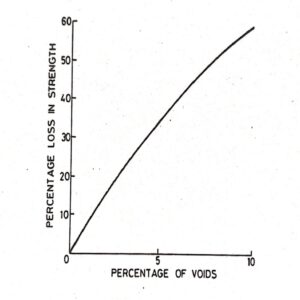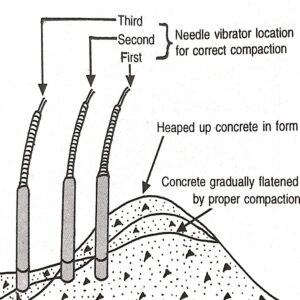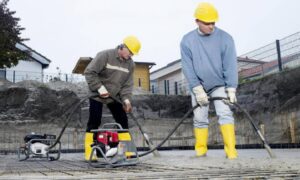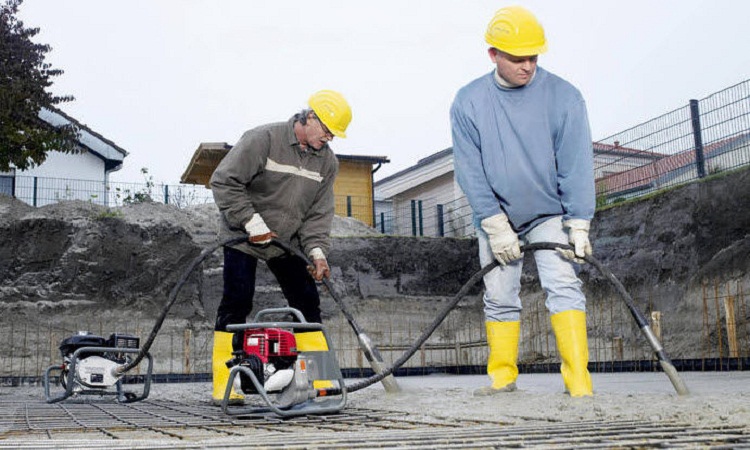Compaction or consolidation of concrete is necessary to remove entrapped air which is present in concrete after it is mixed, transported, and placed. Compacting also helps eliminate stone pockets and thereby eliminates all types of voids that may possibly be left in the concrete, causing a reduction in strength as well as durability.
Compaction or consolidation of concrete is required to get rid of entrapped air and voids as much as possible, down to less than one percent in normal concrete. The amount of entrapped air is directly related to the workability of concrete. The lower the workability, the higher is the percentage of entrapped air. In other words, the stiff concrete mix has a high percentage of entrapped air or voids and therefore would need higher compaction effort than highly workable mixes.
Methods of Compaction of Concrete
Compaction or consolidation of concrete can be carried out either by hand or by machines. The different methods for compaction of concrete are given below:
- Hand Compaction Method
- Mechanical Compaction Method
- Shock or Drop Table
- Centrifugation
- Vibration Method
- Internal Vibration
- External Vibrator
The Importance of Removal of Entrapped Air or Voids from Concrete
- Voids reduce the strength of concrete. With every one percent entrapped air the strength is reduced by about 5% to 6%. Five percent entrapped air means 30% loss of strength.
- Voids increase the permeability of concrete. Loss of impermeability makes an easy passage of moisture, oxygen (O2), chlorides, and other aggressive chemicals into the concrete. The causes resulting of steel and spalling (disintegration) of concrete i.e. loss of durability.
- Easy entry of sulfates from the environment causes an expansive reaction with the Tricalcium Aluminate (C3A) present in cement. This causes disintegration of concrete & loss of durability.
- Entry of carbon dioxide (CO2) causes carbonation of concrete, i.e. loss of alkalinity of concrete or loss of the protective power that concrete provides to the reinforcement or other steel embedded in it. When the depth of carbonation exceeds the thickness of concrete cover into the embedded steel, steel becomes vulnerable to the attack of moisture. This expedites rusting of steel as the protective concrete cover is no longer alkaline in nature.
- Voids reduce the contact between embedded steel and concrete. This results in loss of bond strength of reinforced concrete member, and thus, the member losses strength.
- Voids such as honeycombs & blowholes on the exposed surface produce visual blemish. Concrete with a smooth and perfect surface finish not only looks good but also is stronger and more durable.

Guidelines for Proper Compaction Using a Poker Vibrator
The site supervisor must watch these points:
- The concrete surface being compacted must be clearly visible.
- Insert the poker quickly and allow it to penetrate, by its own weight, to the bottom of the layer as fast as possible, so that entrapped air is removed uniformly throughout the concrete mass.
- Leave the poker in the concrete for about ten seconds. This compaction time may depend on the slump of the concrete mix.
- The poker must be inserted quickly but the withdrawal must be slow so that the hole left by the poker is filled up as it is being withdrawn.
- Locations of the poker insertion should be staggered to ensure that every bit of concrete is compacted.
- Avoid touching the formwork and steel reinforcement with the poker vibrator. This damages the poker.
- Poker should not be used to make concrete flow through long distances.
- On a heaped concrete, the poker position should be changed gradually from the side of the heap and moving away from the heap all around. Poker shouldn’t be introduced in the center of the heap.
- The poker should extend about 100mm into the previous layer.
- The poker must be penetrated into the concrete fully.
- Avoid sharp bends in the flexible drives and thereby prevent damage to the drive.
- The Drive motor of the poker should not cause vibrations on the staging. Do not drag the drive motor by pulling the flexible shaft of the drive.
- In a massive pour, station the various drive motors at such locations so that they do not have to be shifted back and forth with every layer of concrete.
- It is better to have more vibrating motors than fewer, even if all are not required simultaneously.
- Drive motor should be switched off when the poker is not in concrete.
- It is safer to over vibrate the concrete than to under vibrate.
- Keep enough spare pokers with flexible drives available as standby.
- Do not use the poker vibrator continuously for a long time. Intermittent rest is necessary.
- The concrete layer to be compacted should not be deeper than the head length. This is necessary as there is a danger of the top part not being fully compacted.
- The operator must hold the needle vibrator at least 60cm to 75cm above the point where the needle head and flexible shaft are connected.
- To make optimum use of poker, the vibrator is necessary to plan compaction in advance along with placing method and techniques.


Duration of Compaction
When to stop compaction? This question is often asked. It is a matter of judgment and feel of concrete compaction an individual has, which generally helps him to know when to stop compaction. The points indicated below will also help the worker or the supervisor as to when he has to stop compaction.
- Initially, as the poker is inserted in concrete, the mix settles and the level drops. If compaction is continued further, entrapped air bubbles rise to the surface and are clearly visible. As soon as bubbles stop emerging, it is understood that compaction is completed.
- When the poker’s pitch (whine) becomes constant, the concrete is compacted. The skilled operator can easily make out from the sound emitted by the vibrator.
- A thin shining film often appears on the concrete surface or from between the formwork and the concrete. This is another indication that the concrete has been fully compacted.

Over Vibration
A good cohesive concrete mix will withstand over-vibration, but a lean concrete mix will segregate and result in the concrete of non-uniform strength, quality, and durability. Concrete will be weaker at the top and would develop cracks and will not perform to the extent desired.
Over vibration results in excess laitance on the top surface, this in the case of columns and wall tops can be easily removed by chipping while preparing the construction joint.
However, in the case of slabs, this removal is impossible. Therefore, excessive laitance formation must be avoided either by using a cohesive mix not likely to bleed and/or not overworking the surface with the poker vibrator. However, in the case this is not completely possible after the compaction is over the top surface can be scooped up once again using a fork and coarse aggregate brought on to the surface and then leveled and compacted with afloat.
Initial Setting Time of Concrete
The initial setting time of concrete is the time required for the mix to stiffen after which compaction is not possible, the initial setting time of concrete can depend on the following factor:
- Initial setting time of cement used in concrete.
- Quantity and type of cement used in the mix.
- Ambient temperature and wind conditions.
- The temperature of the water and other ingredients used in concrete.
- Use of chemical additives such as retarders.
- Workability and temperature of the concrete.
- Absorption of water by aggregates in concrete.
If a massive pour is required to be done it is essential to know the setting time of the mix in field conditions. This can be done by observing the compaction of a sample concrete of identical mix and in identical conditions. The poker is then inserted and withdrawn at different intervals of time-say 15 mins to 30 mins. If the poker is unable to sink into the concrete under its own weight or it leaves a hole when withdrawn slowly, it means that the initial setting of concrete has begun and the time when this happens is the initial setting time of concrete in the field.
If this time is observed, to be saying one hour, then keeping a safety margin, the placing of concrete has to be planned in such a manner that the subsequent layers of concrete are placed within 30 mins of each other, the other 30 mins being the safety period for unforeseen stoppages and unknown problems. The safety period has to be suitably increased if standby equipment or other facilities are not planned or available.
Revibration
As long as the concrete is still workable (still not achieved its initial set), there is no harm if it is revibrated. Tests have shown an increase in strength due to revibration.
On walls and columns, where the finish of the surface is significant, there is sometimes a tendency for blowholes to happen in the top 600mm of a lift. The reason is that, unlike the lower layers, this top layer does not have the advantages or the weight of additional concrete on top to increase the compaction. It can be advantageous to revibrate the top 600mm of concrete after the initial compaction but before it achieves the initial set.
It is also observed, that in hot weather, concreting shrinkage cracks are reduced if the concrete pour in slabs is lightly vibrated initially and then revibrated after a lapse of time. Revibration and refinishing help reduce shrinkage cracks.

